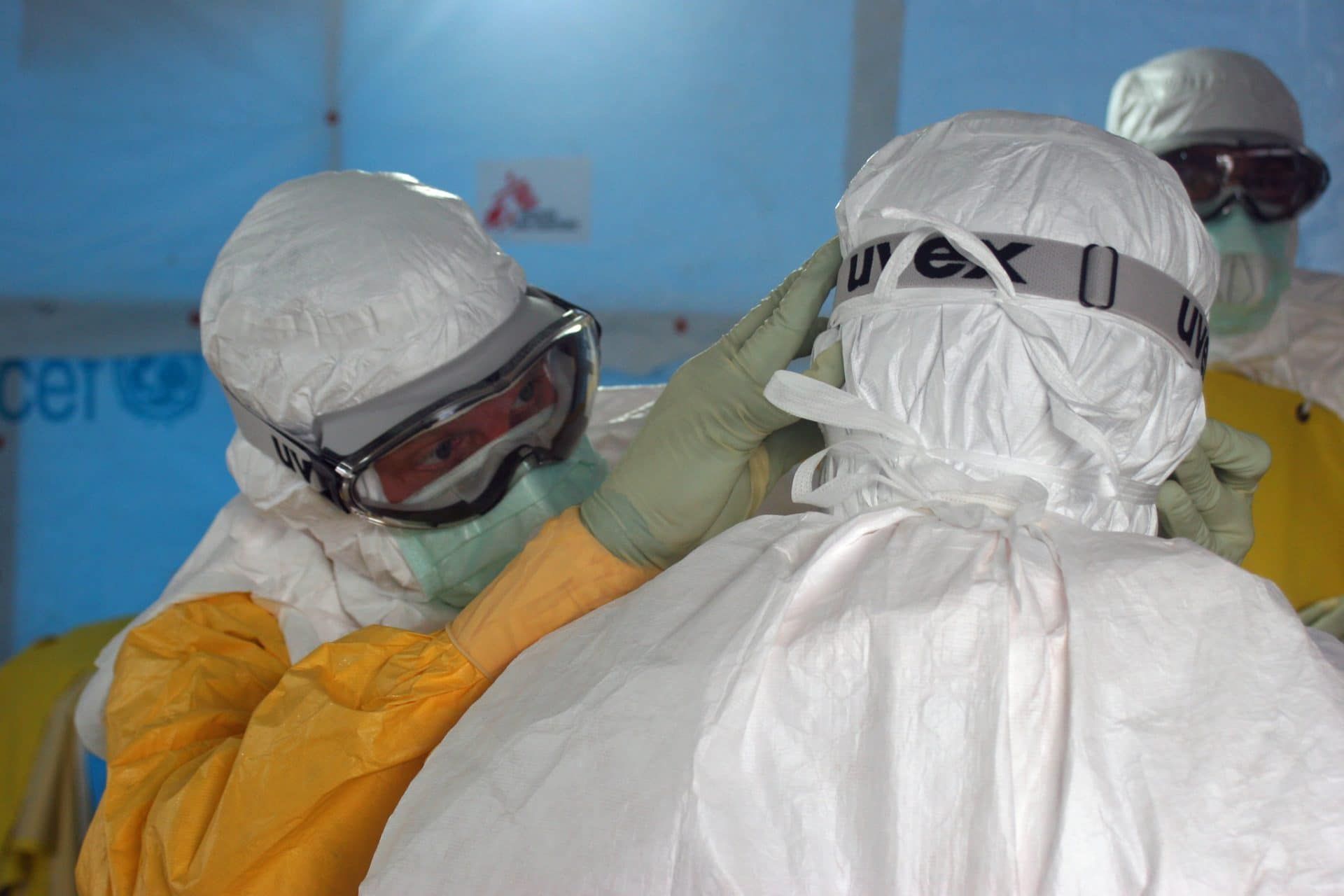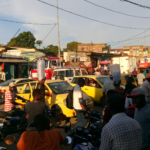Outbreaks of lethal diseases happen regularly. The US government just cut funding for the hospitals that deal with them
By Saskia Popescu | January 22, 2020
 Nina Pham, a nurse who contracted Ebola while treating a patient in Texas, recovered and was discharged from the National Institutes of Health's Clinical Center in October, 2014. Credit: National Institutes of Health.
Nina Pham, a nurse who contracted Ebola while treating a patient in Texas, recovered and was discharged from the National Institutes of Health's Clinical Center in October, 2014. Credit: National Institutes of Health.
When a Liberian man named Thomas Duncan first showed up at a Dallas hospital in September 2014 with a fever and abdominal pain, he was sent home with some antibiotics. Days later, Duncan was dead from Ebola. Outbreaks of dangerous diseases like Ebola or the new respiratory coronavirus that’s killing people in Wuhan, China—cases of the latter now have appeared in other countries, including the United States—are a feature of modern life, not a bug. And it’s only a matter of time before a patient shows up at a doctor’s office somewhere in the United States suffering from what could be the next epidemic disease.
Hospital practices can expose healthcare workers and others to infection. The type of failures that resulted in two of Duncan’s nurses becoming infected with Ebola were prolific in the US healthcare system, even before the 2014 crisis. According to Nina Pham, one of the nurses who contracted Ebola, her preparation for caring for an Ebola patent “consisted of what her manager ‘Googled’ and printed out from the internet.”
After Duncan died, US health officials put in place a strategy to prepare hospitals to deal with patients who had diseases like Ebola, caused by so-called special pathogens. This tiered response system consists of frontline and assessment hospitals that determine whether or not patients have a serious infectious disease and higher-level hospitals that can treat patients with these dire infections. The tiered approach has significant flaws, but it’s a whole lot better than the haphazard structure that was previously in place. Unfortunately, federal funding for the program is set to expire this year, and save for a small number of specialized treatment facilities and an Ebola education center, Congress did not include funding for the program in the 2020 budget.
The US response to Ebola. During Duncan’s hospitalization and following his death, the federal government issued interim guidance to hospitals asking them to prepare for and respond to potential Ebola cases. Later, federal officials created instructions for a tiered system of healthcare facilities based on what level of care different hospitals would provide.
The federal guidance instructed hospitals, laboratory personnel, clinicians, and other responders on wide array of safety practices. For many healthcare providers, the Ebola crisis required them to play catch up. They had to acquire the most current protective gear, to implement patient movement algorithms (programs that determine how to expose as few people as possible to a disease when moving a patient through a facility), and to ensure proper environmental disinfection and waste removal.
Staying abreast of the latest recommendations and ensuring frontline healthcare staff were properly trained was a daunting task and for many hospitals, not a sustainable one. Maintaining such a high level of preparedness was also extremely costly. The US hospitals designated as Ebola treatment centers (there are now 60, up from an initial 55), spent an average of $1.2 million per hospital in about a year. There is little data on how much the frontline hospitals—the facilities that were at least prepared to assess whether or not patients might have Ebola—spent preparing for disease. But nationally, a 2017 study found that Ebola preparedness efforts cost US hospitals $361 million in 2014-2015.
In 2015, Congress finally funded the tiered framework of Ebola care facilities. For me and others in the field, the announcement of a new approach provided much needed relief. The Department of Health and Human Services was tasked with creating a regional strategy for caring for patients infected with special pathogens, a category which also includes diseases such as severe acute respiratory syndrome, or SARS, an often-fatal viral illness first identified in Asia, and Lassa Fever, a viral hemorrhagic disease endemic in parts of West Africa. The Department of Health’s Hospital Preparedness Program built out a four-tiered network of hospitals. The tiers include 10 Regional Ebola and Other Special Pathogens Treatment Centers, which can provide enhanced care and receive a patient within eight hours, dozens of other Ebola treatment centers spread out across the country, 217 Ebola assessment hospitals, and some 4,800 frontline healthcare facilities.
The expectations are that frontline facilities should be able to quickly identify and isolate potential patients and transfer them to an assessment or treatment hospital if necessary. Assessment hospitals need to have the necessary personal protective equipment and capabilities to manage a patient for 96 hours until a diagnosis is confirmed or ruled out via a laboratory evaluation. The treatment centers provide treatment to confirmed Ebola patients. At the top of the tiered structure, the 10 regional facilities have the capabilities to simultaneously treat at least two Ebola patients and to isolate at least 10 patients with a respiratory special pathogen like SARS or Middle East respiratory syndrome (MERS).

A problematic solution. The tiered approach ensures there are hospitals and healthcare workers equipped to handle special pathogen cases, but like many public health responses to infectious diseases, it’s a Band-Aid, meant to deal quickly with outbreaks before they spiral out of control.
The tiered structure addresses this problem by having some hospitals (i.e., the frontline facilities) prepare simply to assess a patient who might have a special pathogen. But this approach means maximum exposure of healthcare workers. Should a patient with diarrhea and nausea walk into a frontline healthcare facility after having travelled to a country like the Democratic Republic of the Congo and having possibly interacted with someone with Ebola, he or she would be considered at high-risk for having the disease. A patient could be transferred from that frontline facility to an assessment hospital and then on to a treatment center, increasing the risk that others become exposed along the way. Moving a so-called wet patient who is suffering from diarrhea and nausea, common symptoms of Ebola, is even riskier. Even when hospitals use isolation pods developed for this very reason, as a rule, transferring a patient translates to putting more healthcare workers at risk.
A second issue with the tiered framework: There are simply not enough beds within the treatment centers to manage a large outbreak. If each treatment or regional center has two to three beds for a patient with a disease like Ebola, the entire system would have beds for only about 200 patients. In a larger outbreak, the system would not be able to keep up.
Finally, there is a flip side to relying on the specialized treatment centers during an outbreak: Expertise gets concentrated in the higher-tier hospitals, and there is little incentive for frontline facilities—the majority of hospitals in the United States—to maintain costly preparedness for events they view as unlikely. These are also the hospitals most likely to have a patient like Duncan—or someone with the novel coronavirus from China—walk through their doors. The frontline hospitals weren’t a major focus of the 2015 funding and are likely to let their special pathogen preparedness efforts slip further as the tiered program is dismantled.
Better than nothing. Despite the flaws with the existing tiered system for dealing with special pathogens, it’s a more comprehensive and better resourced approach than what was in place before the 2014-2016 Ebola epidemic. As it stands, Congress has funded the 10 advanced treatment facilities and the National Ebola Training and Education Center but not the 60 treatment centers included in the tiered network. (The nearly 5,000 frontline hospitals never got much federal funding for their special pathogen-related efforts.) Trump signed the bill into law in December.
Caring for patients with a disease caused by a special pathogen can be extremely costly. Each patient requires more staff, supplies and administrative resources. And many professionals with experience working in Ebola treatment centers worry that without continued federal funding, the network will deteriorate. “Funding is running out in 2020, and this creates a real risk of decreasing our national preparedness,” Jennifer Andonian, a project manager for Massachusetts General Hospital’s Center for Disaster Medicine, says. “Even after hospitals have developed good … plans and facilities, there are ongoing costs to keep staff trained and to use their equipment in practice.”
A quick survey of the World Health Organization website is all it takes to understand just how frequent outbreaks of serious pathogens are. Syra Madad, a senior director at NYC Health + Hospitals, New York’s public hospital system, says that maintaining support for the tiered network of special pathogen treatment facilities “is vital not just for health security but for national security.”
To be clear, many dangerous pathogens, including the disease now spreading in China, can be treated at run-of-the mill hospitals in the United States. A cost of over a million dollars per treatment center is no easy pill for hospitals to swallow, even as many have adapted their specialized bio-containment units for uses other than the care of an Ebola patient. My own experience, echoed in surveys and studies, is that hospitals are unlikely to invest the necessary resources to prepare for somewhat improbable events like an Ebola epidemic in the United States. It’s easy to imagine administrators asking, “Why worry about Ebola when we are running out of influenza testing kits?”
The next epidemic could start with a patient checking in at a local urgent care clinic. Congress needs to ask if its current plan for special pathogen response prepares the country for that.
It’s likely the answer is no.
Read more Bulletin coverage on the Coronavirus outbreak here.
Together, we make the world safer.
The Bulletin elevates expert voices above the noise. But as an independent nonprofit organization, our operations depend on the support of readers like you. Help us continue to deliver quality journalism that holds leaders accountable. Your support of our work at any level is important. In return, we promise our coverage will be understandable, influential, vigilant, solution-oriented, and fair-minded. Together we can make a difference.
Keywords: China, Coronavirus, Ebola, MERS, SARS, Wuhan, outbreaks
Topics: Analysis, Disruptive Technologies
















In my city of Suzhou, the city hall has appropriated funds to the frontline healthcare hospitals to establish fever clinic center only, separating walk-in patients with fever symptoms from any other medical emergencies. There have been only 4 confirmed cases of coronavirus citywide, so these hospitals have enough resources to respond so far.
It amazing we can fund building a useless wall yet fail to fund something this important.